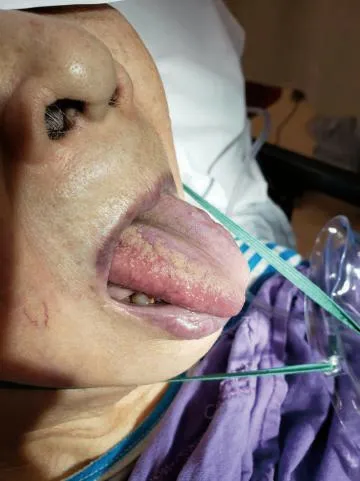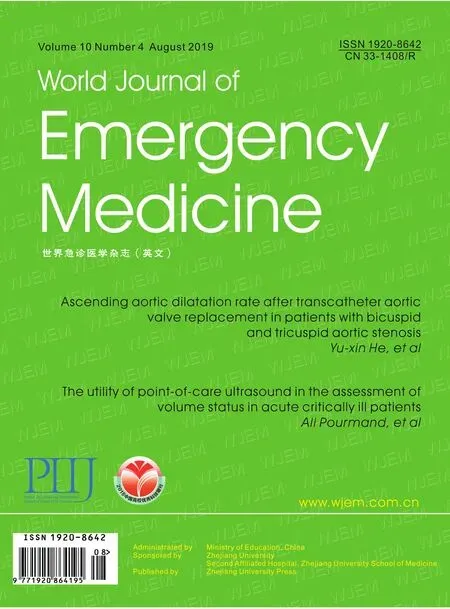My mother is looking blue
2019-09-19HowardTatChunChanAnselmWangHeiHuiColinGrahamJosephWalline
Howard Tat Chun Chan, Anselm Wang Hei Hui, Colin Graham, Joseph Walline
1 Department of Accident and Emergency Medicine, Hong Kong Hospital Authority, Prince of Wales Hospital, Shatin, Hong Kong, China
2 Accident and Emergency Medicine Academic Unit, The Chinese University of Hong Kong, Prince of Wales Hospital,Shatin, Hong Kong, China
Dear editor,
A 76-year-old Chinese female presented by ambulance to the Emergency Department complaining of dizziness, headache and fatigue. Her son claimed that the patient “turned blue” three hours prior to onset of the patient’s symptoms. Paramedics noted the patient’s SpO2was 83% on room air with no improvement with a nonrebreather mask. Past medical history was signif icant for diabetes and hypertension. Family, social and medication history were non-contributory. Patient denied ingestion of any traditional Chinese medicines but did have some choy sum (a variety of green vegetable) for lunch five hours prior to arrival. On examination, the patient appeared agitated, but alert. Purple lips and fingers were noted (Figure 1). Physical examination: heart rate 55 beats/minute, pulse oximetry 87%, respiratory rate 16 breaths/minute, blood pressure 143/51 mmHg.Bedside investigations: chest X-ray (clear lung f ields and cardiomegaly); ECG (sinus rhythm, slight bradycardia at 53 beats/minute); hemoglobin 9.3 g/dL; glucose 10.9 mmol/L (196.2 mg/dL).
Diagnosis: acquired methemoglobinemia due to choy sum poisoning.
The patient’s blood gas Met-Hb level improved from 29.7% (normal level <1.5%) at presentation to 1.2%three hours after initiation of treatment with methylene blue (1-2 mg/kg over five minutes). The patient’s color normalized during this time as well (Figure 2). Twentyone hours after treatment began repeat Met-Hb was 0.5%. Urine and plasma samples were sent for nitrite and nitrate testing. The case was reported to local poison control center and the Department of Health as suspected choy sum poisoning. The remaining vegetable samples were removed. The patient recovered and was later discharged with no complications.

Figure 1. Patient’s cyanosis (darker purple coloration) around lips and tongue.

Figure 2. Patient’s resolved cyanosis around lips and tongue.
DISCUSSION
Choy sum, choi sum, or cai xin is a common green leafy vegetable used in Chinese cooking.Methemoglobinemia can present in congenital (rare)or acquired (common) cases.[1-3]The elderly and infants are most at risk for acquired methemoglobinemia,particularly from medications (e.g. dapsone, benzocaine),food-borne nitrates or fertilizers.[4-6]Central cyanosis not responding to oxygen is pathognomonic. Check a blood gas with included Met-Hb analysis to make the diagnosis.Methylene blue, ascorbic acid, exchange transfusion, and hyperbaric oxygen are potential treatments, depending on availability and/or severity.[7]Identify and remove the offending agent (medications are the most common cause), and consider poison control / official reporting if there is a public health concern, as well as patient education on avoiding offending agents.
Funding:This study had no funding or conflicts of interest to report.
Ethical approval:Not needed.
Conf licts of interest:The authors have no conf lict of interest, no f inancial issues to disclose.
Contributors:HC and AH cared for the involved patient, took photographs ensuring patient anonymity and researched background material. CG and JW guided the project and drafted the manuscript.All authors were involved in the final editing of the manuscript and preparation of materials for submission. The manuscript has been read and approved by all the authors, requirements for authorship have been met by each one, and each author believes that the manuscript represents honest work.
杂志排行
World journal of emergency medicine的其它文章
- Information for Readers
- The utility of point-of-care ultrasound in the assessment of volume status in acute and critically ill patients
- Application of 4% formaldehyde under electronic colonoscope as a minimally invasive treatment of chronic hemorrhagic radiation proctitis
- Instructions for Authors
- Continuous B scan ultrasound guided post-traumatic sub-periosteal orbital hematoma drainage: An advantage over routine needle drainage procedure
- Empyema and mediastinal abscess in pyriform sinus f istula: A case report
